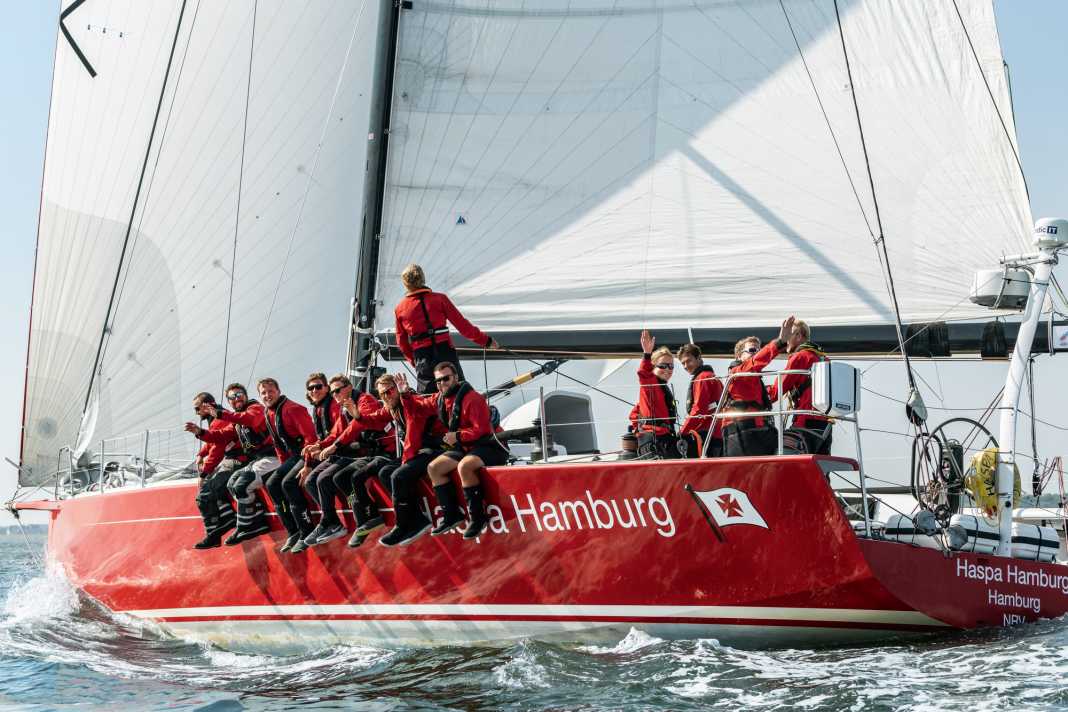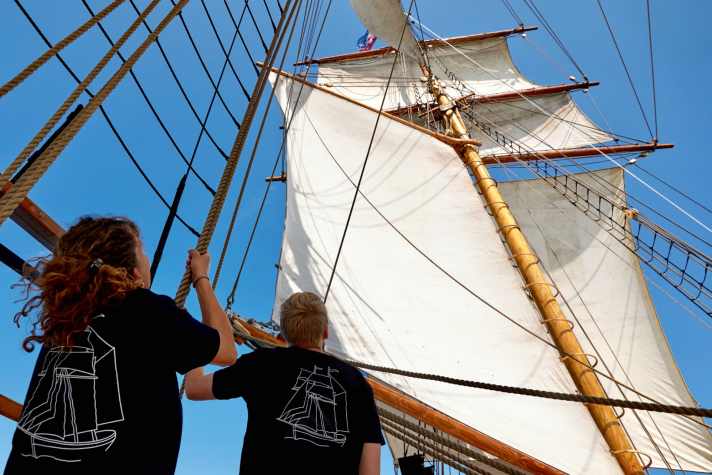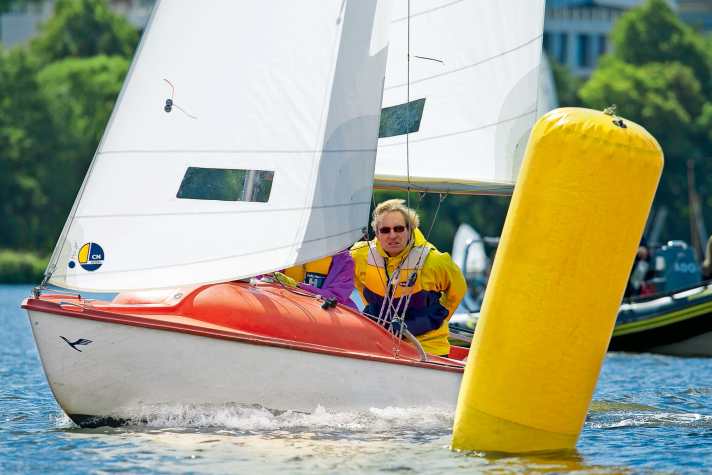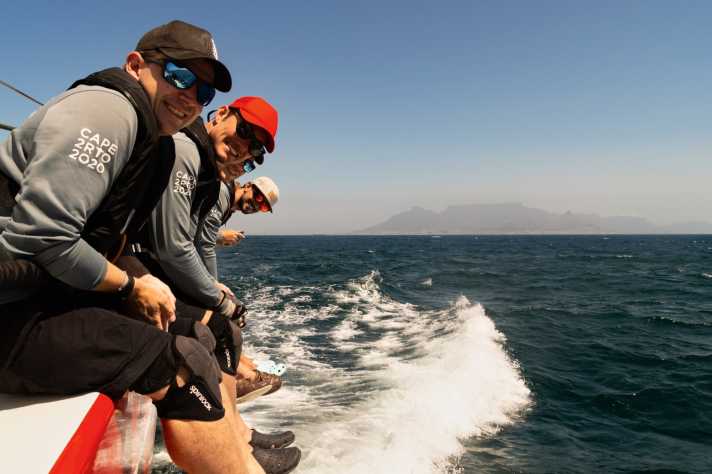





An old clubhouse by the water. Standers from various sailing clubs hang from a long line under the ceiling. Trophies gleam in two display cases on the wall. The windows offer a view of a jetty. Inside, grouped around a large table, a dozen or so sailing students sit bent over examination sheets. "Time's up," says one of the examiners present, "please hand in now." A collective sigh goes through the room. You've done it! But did you pass?
Two hours later, great relief. No one has failed. But what happens now? Okay, the practical exam is still to come. Before that, most of them will go on practice trips for a few more days. Nevertheless, once the licence has been obtained, it is far from clear to everyone when, where, with whom and whether they will even set sail next time. The will is usually there, but often the means are lacking. In particular, not every beginner sailor wants to buy their own boat straight away. Sometimes there is a lack of money anyway. Or fellow sailors. Or the time required to look after a boat.
However, this is no reason to stop sailing in the first place. There are plenty of opportunities to go sailing without your own yacht, and sometimes even for comparatively little money. Rainer Weber, for example, has regularly sailed on berth charter trips with various skippers for years. Most recently, the 58-year-old explored the Adriatic coast together with other berth charterers. "For me, it's the ideal way to go on holiday," says Weber. "I love being on the water. But it wouldn't be worth it for me to have my own boat. I also like being able to discover completely new areas again and again." Of course, it is also much cheaper to charter a berth instead of a whole boat.
Various offers depending on the sailor's preference
Once she had her licence, Renate Jung also remained faithful to sailing, even though she doesn't own a boat. "I joined the local sailing club. This has given me many sailing opportunities." According to Jung, she can use the existing club boats and also socialise with fellow club members. "They take me out on their boats from time to time. Some owners are happy to have an extra hand on deck."
These are just two examples that show that there are many ways onto the water. Interested parties should consider their preferences in advance: Would you prefer to do a few laps on the nearest inland waterway at the weekend? Or do you fancy longer trips to distant sailing areas? Are you a cruising sailor? Or are you looking for an adrenalin rush on the regatta course? Ultimately, the budget is also a deciding factor: hand-against-boat cruises, for example, are also something for those on a tight budget. The same goes for some boat-sharing models. Berth charters or even shared ownership, on the other hand, are somewhat more expensive.
Below we have summarised the offers available from associations, institutions and commercial providers. They all open up unimagined possibilities.
For all ages and skill levels: the sailing clubs
One way to get started in the exciting world of sailing is to join a sailing club. In addition to those that organise their own boat operations, clubs without club boats are also interesting. Here you can socialise with experienced sailors. Many small sailing clubs also have a junior section. In the Opti or later in the junior dinghy, children and young people develop an interest in sailing at an early age. There is a sailing club near you almost everywhere in Germany. A list can be found on the website of the German Sailing Association (dsv.org).
There are also the large German, nationally recognised associations. One of these is the Hamburgischer Verein Seefahrt. It organises its own deep-sea shipping operations. With the three sailing yachts "Störtebeker", "Haspa" and "Broader View Hamburg", crews from the association regularly take part in major events such as the Fastnet Race, the Middle Sea Race and the Sydney Hobart Race. The aim of the association is to enable young sailors to start and train in ocean sailing.
Clubs offer everything from Opti courses to offshore sailing
Numerous academic sailing clubs, such as ASV Hamburg or ASV Wismar, offer a similar programme aimed specifically at students. Just ask around at your own university to see if there is a corresponding sailing department. The Kieler Segel Club Baltic also offers a wide range of club boats, including optimists and dinghies, an X-79, a J/80 and a folk boat.
The sailing club Wappen von Bremen (SKWB) is focussing on ocean sailing with its three club yachts. "Our programme is aimed at people of all ages who are enthusiastic about sailing and want to gain experience on the high seas," explains Michael Rapp, Chairman of the SKWB. "We are always happy to welcome committed people." The SKWB is a training organisation that starts at the age of 15 and practically never ends, says Rapp. The Bremen-based organisation also offers round trips that focus on classic cruising in holiday destinations. Rapp: "We also offer taster weekends to find out whether ocean sailing is something for you personally."
Other sailing clubs also sometimes have their own boats, which are not moored at the local jetty. Instead, they are moored on larger inland waterways, such as those in the Netherlands. Or on the Baltic Sea, so that club members can go on coastal cruises there. Last but not least, there are often like-minded people in many clubs who are aiming for the next licence. And who study and sail together for this purpose.
- For whom: from Opti children to teenagers and young adults to the older generation
- Sailing skills required: Varies depending on the age of entry and the organisation of the club
- Costs: Membership fee plus any contribution towards expenses for participation in cruises on club ships
On a foreign keel: Berth charter and hand against berth
Sailing for a fortnight in the Caribbean, sitting down to a fully laid breakfast table every morning - who doesn't dream of that? In addition to bareboat charters, i.e. the rental of a complete yacht, which are very expensive for many, berth charters have long since become a popular option for sailing holidays. It is not only more affordable. You also don't have to worry about almost anything. The professional skipper takes the responsibility off the paying guests!
If you like, you can usually still take part in sailing. Berth charter offers are mainly available in sunny sailing areas such as the Mediterranean and the Caribbean. However, offers can also be found for the German-Danish Baltic coast.
Charter provider Mola, for example, is present in this area with berth charter trips. A well-known provider for the southern climes is Wolfgang Stuis (sailingcroatia.com). He was pretty much one of the first berth charter providers in this country and can look back on many years of experience in the segment. In addition, numerous other offers can be found on the Internet on the usual online marketplaces.
Customised berth charter trips and "hand for berth" offers
In addition to the large charter fleet operators, individual ships also organise berth charter trips, usually with a very individual focus. For example, Christoph von Reibnitz's "Peter von Seestermühe", Constantin Claviez's "Charisma" or Leon Schulz's "Regina Laska". In most cases, active sailing is the order of the day on these ships, including watchkeeping and bakehouse duties.
The free variant of the berth charter is known in sailing jargon as "hand for berth" (HgK). Sometimes it is customary to contribute to the on-board cash for provisions, mooring fees and diesel. The skipper is expected to actively help with the management of the ship. Interested parties should therefore be fit enough to take over a watch. Co-sailors are often sought for long trips, such as transatlantic voyages.
HgK offers can be found in many sailing clubs among club mates. But owners and fellow sailors also come together in various Facebook groups. There are also special websites, such as handgegenkoje.de or oceancrewlink.com.
- For whom: Teenagers and adults
- Sailing skills: As a rule, none are required. Depending on the trip, however, more or less active participation in the boat management is definitely desired or even required, especially on the "hand against berth" trips
- Costs: Usually only a fraction of a bareboat charter, depending on the area, ship size and trip duration
Shared sailing fun: boat sharing
Why buy your own boat when you can hire one? And on a regular basis and at a reasonable price. What works on the road also works on the water - keyword boatsharing. There are various providers, each with a different organisational form, focus and price structure.
One is the Hamburg Sailing Association (SGH). The association operates two Kielzugvögel and two EFSix keel dinghies on the Outer Alster. The association also offers a co-sailing exchange, a network in which one or two Baltic Sea sailors are also at home. Adults can become SGH members for a monthly fee of 25 euros plus an admission fee of 150 euros. Young people, trainees and students receive a discount. Members can then use the boats as often and for as long as they like.
Boat sharing in Switzerland
In Switzerland, there is the boat-sharing provider Sailbox. It is comparatively more expensive. The "Skipper Basic" membership costs the equivalent of around 300 euros per year, plus a one-off deposit of around 1,000 euros. In addition, every hour sailed during the week costs around 55 to 65 euros, and ten euros more at weekends. Sailbox boats are available on 13 lakes, such as Lake Maggiore, Lake Lucerne, Lake Zurich and Lake Constance. The Swiss sail with boats of the type mOcean, an eight-metre daysailer. The boat has been specially developed for boat sharing and can be sailed with or without a harness.
- For whom: Sailors in adulthood
- Sailing skills: Depending on the area, appropriate sailing licences and thus the ability to sail the boats independently and safely must be available
- Costs: Varies greatly from provider to provider
Interview: three questions for Udo Lang, SGH

YACHT: Mr Lang, who is your boat-sharing service aimed at?
Udo Lang: Our offer is primarily aimed at people who want to go sailing on the Outer Alster in Hamburg after work. This could be people who have not sailed for a long time, have a boat moored somewhere, for example on the Baltic Sea, and therefore only spend the weekends there. Or people who come to Hamburg to study or work and are looking for a place where they can relax and enjoy their evening after work.
How does boat sharing work in the sailing community?
Two boats can be reserved via a list in the landing stage. For the other two boats, there is a Google calendar in which our members can enter their names. The four club boats are all moored at Bobby Reich's jetty. Our members can then cast off from there. We have just under 60 members, some of whom have more time, others less. However, there is always a boat available, even to go out on the water at short notice.
Are SGH members allowed to take guests on the boats?
Yes, they are always welcome here. Some of them join SGH themselves because they like the atmosphere here so much. If members bring friends or acquaintances with them, they pay ten euros per day into our guest fund.
Best friends: Owners' associations
Not enough money for the yacht of your dreams? But you don't want to do without it either? Then a community of owners could be the solution. These are available in different variants, sometimes with two, three or more parties. The calculation is quite simple: if two owners share a boat, all costs are usually halved, from the purchase price to the mooring and maintenance costs to the insurance premium. There are now even internet portals that bring together people interested in sharing a boat. You can also often find requests and offers for shared ownership on the notice boards of many sailing clubs or on the usual online marketplaces.
An owner's association can even be a useful instrument for families. The parents often take on the running costs of a boat, while the adult children contribute their share in the form of boat maintenance work. This relieves the burden on some because they are no longer as physically fit. And the next generation can set sail without being financially burdened.
Whether with strangers or family members: Clear agreements and rules as well as a certain degree of tolerance and willingness to compromise are important for every community of owners.
- For whom: for large keelboats adults, also interesting for young people in the dinghy sector
- Sailing skills: The different parties should each be confident enough in handling the boat to entrust it to each other
- Costs: depends first and foremost on the number of owners and the boat that you purchase together. The more parties, the more favourable for the individual
Three alternatives
Traditional shipping

Many classic tall ships are operated by clubs. They are almost always looking for committed people who are interested in maintaining and sailing the ships. A prerequisite is enthusiasm for old boat craft.
Sailing as a company sport

Many, usually larger, companies have company sports groups with their own sailing department, which operates boats and sometimes also organises sailing trips. In some cases, the programmes are outsourced to clubs, which are then even open to non-company members. One example is the Hamburger Flugzeugbau sailing club, another is the Lufthansa Sportverein Köln.
Regatta offspring

Young ambitious sailors who are ready to get on the edge of the boat in sailing races are always in demand. Sometimes a great opportunity to discover the world. Contacts mostly via clubs.

